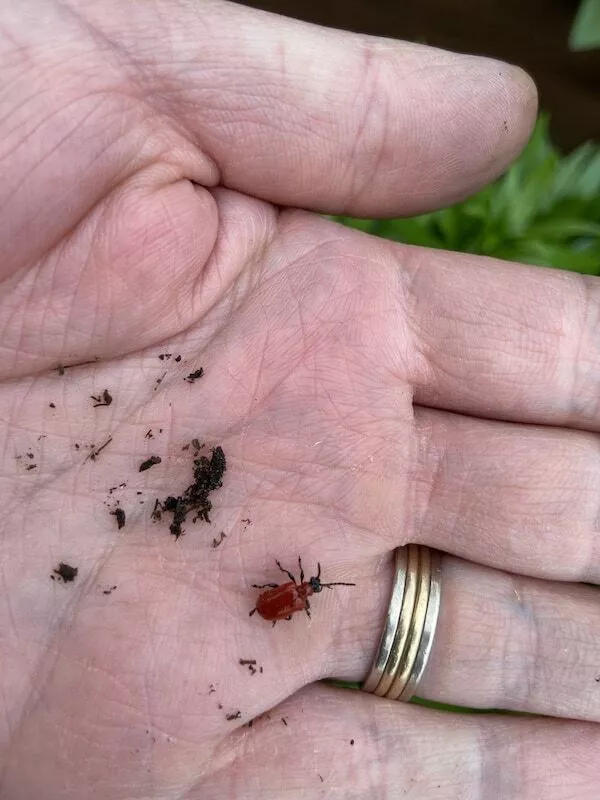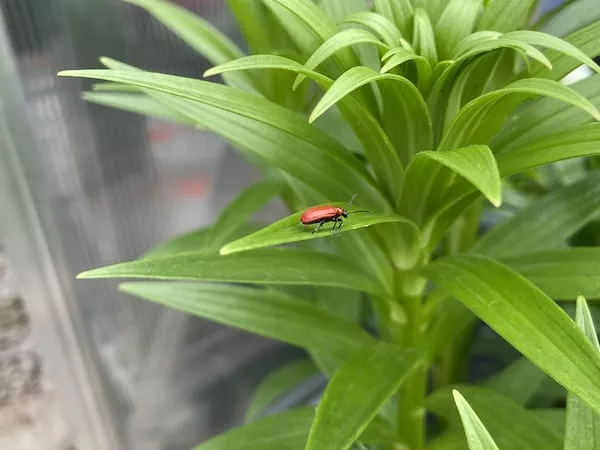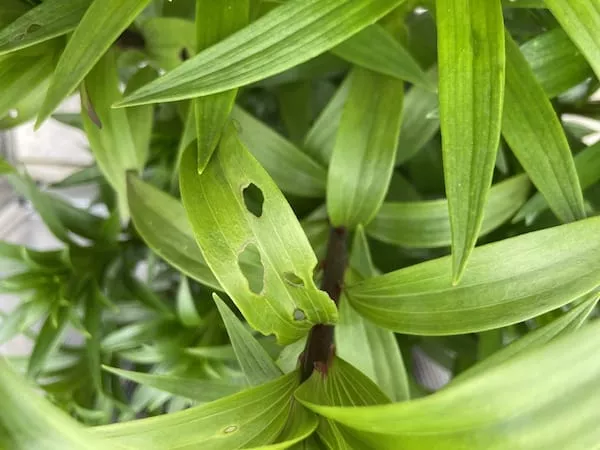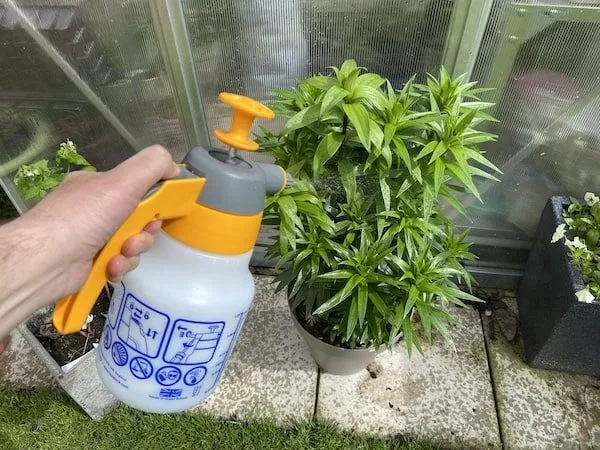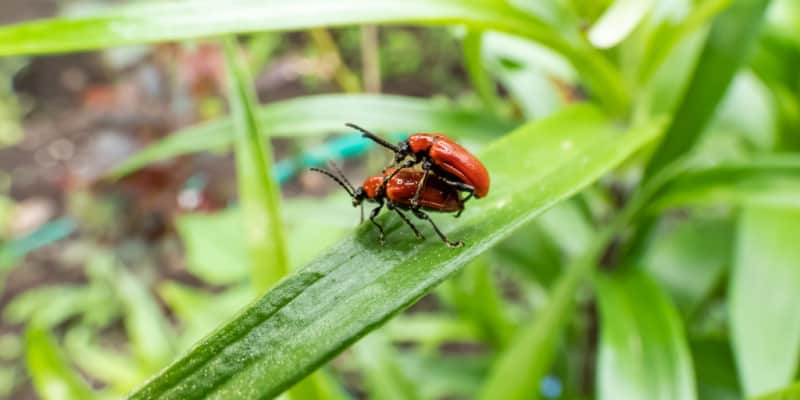
How to get rid of Scarlet Lily Beetles and their larvae
Our site is reader supported, this means we may earn a small commission from Amazon and other affiliates when you buy through links on our site.
The scarlet red lily beetle is without a doubt, a stunning beetle with its bright red wings and black head; however, the damage they cause to Lillies is actually quite astonishing. I have worked in nurseries for over 20 years, and these are one of the main pests we had to be on the lookout for every day. If we didn’t check our Lillies for a couple of days, they could literally strip the leaves of a batch of Lillies in the meantime. These days, it’s the Lillies in my own garden I need to keep an eye on, and it’s important to be on the lookout daily and deal with them as soon as you see them.
The short answer to ‘how to control red lily beetles’ is to hand pick the beetles in the morning, being careful not to knock them off because they purposefully fall onto their backs and become very difficult to spot. This is actually a defense mechanism, and it’s proven to be very effective. If you have a bad infestation of their grubs (larvae) which live on the underside of the leaves, then it may be better to use a spray to control them, using Provanto Ultimate Bug Killer or something similar.
What are lily beetles?
The lily beetle (aka red lily beetle) is actually one of about 250 or so species of leaf beetle. However, none are as damaging as the red lily beetle (Lilioceras lilii). The adult beetle lays its eggs on Lillies, as well as Fritillaries which are part of the Lily family.
The young larvae eat the underside of the leaves while the adults feast on the entire leaves, working from the tip inwards. I have noticed that this damages the leaves but doesn’t seem to really impact flower development, however, it can cause bulbs to be stunted. The exception is really severe infestations which result in under-developed bulbs and poor flowering.
The lily beetle has become more widespread in Britain and Ireland since the 1990s, I personally remember when I’d never even seen a lily beetle. Now, however, I have to deal with them on my own Lillies every single year. They have become a real problem because they are just so widespread.
How to recognise lily beetles
The adult beetle is about 8mm long and has a bright red chest and wings, which luckily makes them easy to spot when you glance into your Lillies, they also have a black head and legs. The young are just as colourful at first. Look on the underside of leaves (April to the middle of summer) for orange/red sausage-shaped eggs. They themselves look stunning. The actual larvae grow to about 8mm long and are rounded and reddish black with black heads. Their secret trick is to hide underneath their own wet black excrement so you may have to dig around a bit to see the actual larvae.
Look for the damage they do on the underside of the leaves, usually brown a light scaring. The adult beetles make rounded holes in the leaves at first but will eventually eat the whole leaf or leave masses of leaves severely damaged. They also move on to snack on flower petals and seed pods.
How can you control lily beetles?
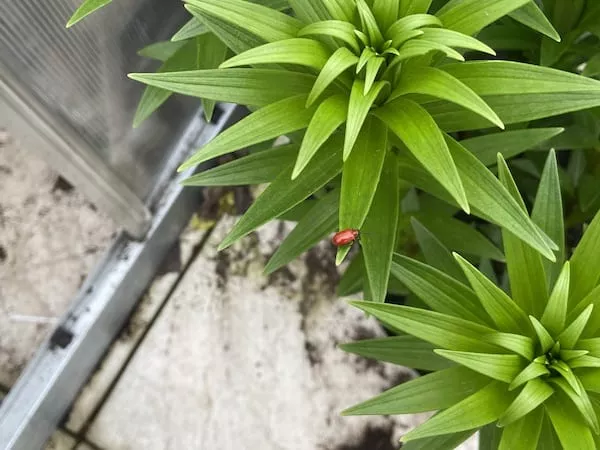
Reducing lily beetle numbers naturally
Encourage the wildlife into your garden that eats lily beetles. Predatory ground beetles love to eat the larvae and sometimes the adult beetles too. Three species of parasitic wasps have a diet only within the larvae of lily beetles. (Lemophagus errabundus, Tetrastichus setifer and Mesochorus lilioceriphilus). Now, this alone will not control lily beetles and it’s more about dealing with them earlier to stop the spread or a least control the larvae. The best thing to do is find and remove the lily beetles as soon as you see them.
How to control lily beetles
You need to treat these lily pests within the growing season. They move elsewhere for the winter, usually to ground level, so you don’t have a chance to get them then.
If there are just lily beetles, remove them by hand – adults, eggs and larvae alike. If you start early enough, you can remove the lily beetles to stop the cycle, so you don’t need to deal with the larvae. What I do is check my Lillies every morning and remove them by hand and then crush them. Once I spot one of the little critters before I try to pick it off I hold a piece of white paper under the leaf so that if it drops off the leaf (which they often do), it lands on the paper and I can still see it. If they land on the soil, you will struggle to see them because they land upside down with their backside up. They can often fall off before you had a chance to pick them off; it’s what they do to protect themselves against predators.
Organic pesticides containing pyrethrins (e.g. Bug Clear Ultra) have a broad spectrum of bugs they eradicate, and work here.
Then move on to a broad spectrum systemic pesticide that contains Flupyradifurone. I usually use Provanto Ultimate Bug Killer. This is useful for ornamental plants such as Lillies. The plant takes in the insecticide because it’s systemic and the leaves and stems become poisoned and so kill the beetles when they feed on them.
Don’t use any sprays if your Lillies are in bloom because that’s a danger to bees and other pollinating insects and definitely don’t spray while bees are active in your garden.
